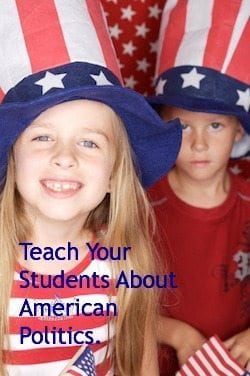
By guest blogger Joann Wasik at TheGateway.org
With the U.S. presidential election less than a month away, the presidential campaigns are in full swing. Each candidate is busy raising campaign funds and vying with each other to promote their messages and views. It’s a fortuitous time to show students how the campaign process works, and how voter attitudes often change over time. Inevitably, many early frontrunners fizzle out, while other political contenders slog along in the shadows until some aspect of their campaign happens to catch the popular imagination. While political campaigns are often viewed as either high drama or theatres of the absurd, they are still a vitally important element in the democratic process.
Political campaigns have been around for millennia. In Pompeii, archeologists have excavated ruins covered with political graffiti, such as “All the goldsmiths recommend the election of Gaius Cuspius Pansa as aedile.” In the 19th century, British politician William Ewart Gladstone is generally acknowledged as having run the first “modern” political campaign, as he gave a series of public foreign policy speeches as a way of introducing himself to curious voters. In 1800, Thomas Jefferson played political dirty pool by claiming that his opponent for president, the incumbent John Adams, planned to marry his son to the daughter of the much-loathed British monarch King George III. Despite the outlandishness of the lie, enough voters believed Jefferson’s accusation that Jefferson amassed more votes and won the election. Other U.S. presidential candidates took a different tack: while his rival William Jennings Bryan traveled the nation by train to address crowds of voters, William McKinley stayed at home during his campaign for the presidency. Occasionally, if enough people gathered outside his home, McKinley would address them from his front porch while his wife served lemonade. It’s unclear exactly when the practice of kissing babies on the campaign trail first began, but most historians trace its origins to Andrew Jackson’s campaign.
For students, there is no shortage of opportunities to learn about political campaigns occurring both in the U.S. and abroad. TV news, Facebook and Twitter feeds, and conventional print and Internet media offer plenty of information on political hopefuls and their upcoming elections. While learning about the political process and the nature of campaigns, students can also learn to examine candidates’ campaign advertisements and messages critically, seeking to separate propaganda from fact. Teachers can also point out the potent use of symbolism in political posters, logos, and speeches by the candidates, and how campaign messages are carefully crafted to appeal to voters.
This week, I’ve selected three resources on aspects of political campaigns that are appropriate for various grade levels. As always, we’ll also be featuring several new lessons and resources daily on this topic on our Facebook and Twitter pages, so be sure to check those pages daily.
Election Bulletin Board
Subjects: Civics
Grade: K-2
In this lesson, students share election-oriented information they gather from the media by constructing a bulletin board of articles and pictures. This lesson was created by Kids Voting USA, Inc., an organization that aims to help students become engaged citizens. To this end, Kids Voting USA offers curriculum materials, activities, and lesson plans that focus on civics education.
Democracy Project: All Aboard the Campaign Train
Subjects: Social Studies, Civics, Government, Math
Grade: 3-6
In this lesson, students raise support for members of their fictional political party at the local, state and national levels while on the campaign trail. Based on a student-created itinerary, the students will map the cross-country campaign stops. The students will estimate arrival and departure times and the distance between stops using an atlas. The students will take time zones into consideration when calculating arrival and departure times. The students will check these estimates by using Internet mapping sites like MapQuest or Vicinity. This resource is a product of PBS TeacherSource, which provides preK-12 educational resources and activities for educators tied to PBS programming. Many resources are correlated to local and national standards.
Elect Me! Creating a Campaign Platform and Advertisement
Grade: 8-12
Students will be a candidate for an election as a United States Representative or Senator in the upcoming election. They will need to decide with party fits their political views best, plan, and present a 3-5 minute campaign commercial about them as a candidate, their platform, and why the voters should vote for them. This resource was produced by The Dirksen Congressional Center, a non-partisan, not-for-profit organization that seeks to improve civic engagement by promoting a better understanding of Congress and its leaders through archival, research, and educational programs.